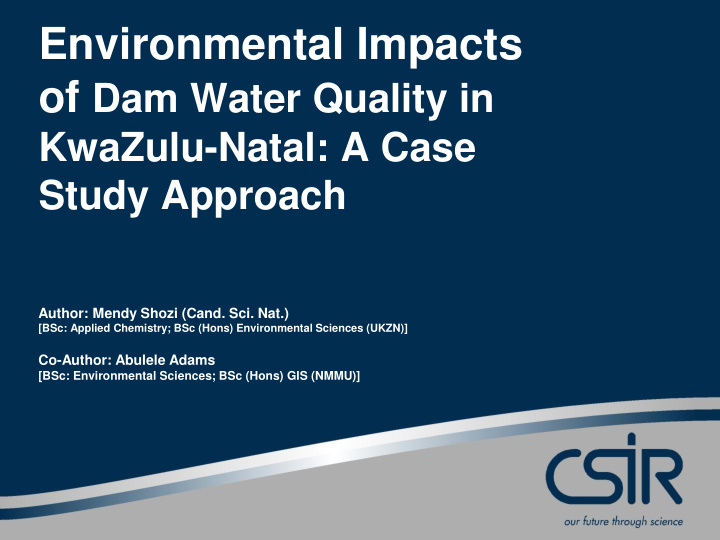



Environmental Impacts of Dam Water Quality in KwaZulu-Natal: A Case Study Approach Author: Mendy Shozi (Cand. Sci. Nat.) [BSc: Applied Chemistry; BSc (Hons) Environmental Sciences (UKZN)] Co-Author: Abulele Adams [BSc: Environmental Sciences; BSc (Hons) GIS (NMMU)]
Outline 1. Introduction 2. Case Study Introduction 2.1. Impact on the four dams 2.2. Case study findings 2.3 Umgeni Water results 3. Discussion on findings 4. Lessons learnt 5. Way forward
1. Introduction • South Africa is facing a looming water crisis • Unsustainable social and economic activities • Metropolitan and residential areas in South Africa are situated in watersheds of rivers e.g. Umgeni Water Catchment
Introduction Figure 1: Residential and commercial areas in close proximity to Umgeni River
• Umgeni Water is a state-owned water utility • Committed to protecting, conserving and sustaining natural resources • Umgeni Water ‘Water Quality Management Plan ’: 1. Monitoring quality of raw water 2. Assessing risks 3. Catchment management activities 4. Improving water quality
2. Case study introduction • The catchment is characterised by a myriad of anthropogenic activities. • Biological and chemical water-borne pollutants contaminate water storage supply.
Figure 2: Location of the four dams on Umgeni River
2.1 Impact on the four dams • Agriculture chemical pollutants (pesticides, fertilizers) • Livestock microbiological pathogens • Alien invasives and plantations blocks and reduces natural flow and may cause soil erosion - sedimentation • Commercial Activity (residential and industry) various chemical pollutants • Residential run-off chemical pollutants, micro- biological pollutants • Overflowing sewage and wastewater works chemical pollutants, micro-biological pollutants • Wetland destruction cannot filter impurities in systems
2.2 Case study findings
Case study findings
2.3 Umgeni Water Results (2012 and 2013) • Dam water quality as determined by Umgeni Water (2012; 2013): Bio-assessment tool Figure 3: The quality of impoundments in the Umgeni River catchment *(Source: Umgeni Water Annual Report 2011/2012; 2012/2013 )
3. Discussion of findings • Case study findings show that dam catchments water quality contaminated • Socio-economic and health impacts of polluted dam and river water. • Umgeni Water Annual Report 2012/2013 reports less contamination. • Disadvantages of solely using biological assessment.
4. Lessons learnt • Numerous benefits associated with effective dam catchment management • Need multi-faceted water quality monitoring scheme • Reduction of treatment costs • Improved ecosystem goods and services received from river catchment • Reduced health risks to water users (domestic, recreational)
5. Way forward • Need for effective integrated water information system (NIWIS) • Polluters must be held accountable • Reduce pollution sources • Greater transparency between local/national government, industry and community members regarding the way forward • Water resource management projects, e.g.: 1. Working on Wetlands 2. DUCT River Walk
6. References Brighton N (2013) Saving Midmar – Meeting Today. River Walks: Journey from the source to the sea G örgens A and de Clercq W (2005) Research on Berg River Water Management: Summary of water quality information system and soil quality studies. Gezina, Water Research Commission Govender D (2011). Midmar Muck. M-NET, Carte Blanche report. Article 4358. Jogiat R (2013) Save the Midmar Dam Project: Working together for water security in the uMgungundlovu Water Service Authority. SANBI Papu-Zamxaka V, Mathee A, Harpham T, Barnes B, Rollin H, Lyons M, Jordaan W and Cloete M (2010) Elevated mercury exposure in communities living alongside the Inanda Dam, South Africa. Journal of Environmental Monitoring, 12 (2): 472-477 Todd, C. and Claasen, M. (2000). Strategic Assessment of the Baseline Environmental Context in Cato Manor: water resources. LEAD Programme in Technology for Enhanced Environmental Management. Durban, March, 2000. Umngeni_Water (2012) Annual Report 2011/2012, Chapter 10: Conserving our natural resources. KwaZulu-Natal, Umngeni_Water (2013) Annual Report 2012/2013, Chapter 9: Conserving our natural reources. KwaZulu-Natal, WRC (2002) State of Rivers Report: uMngeni River and neighbouring rivers and streams. Pretoria, Water Research Commission
Recommend
More recommend